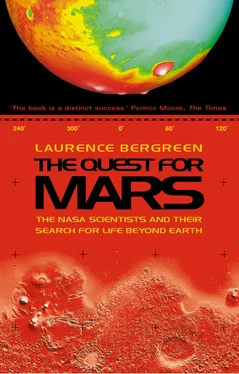At this moment, no one knows for certain if Mars has or had plates similar to Earth’s, or, if the Red Planet did have them, how they operated. If Mars never had crustal plates, their absence poses interesting questions about how it developed without them. And if it did, we see no direct evidence of them – not yet, at any rate. The geologic processes associated with crustal plates would have affected the way life did, or did not, develop on Mars.
“Nothing you see here is more than ten thousand years old,” Jim shouts over the whine of the engine, as we pass over the Reykjanes Peninsula region of southwest Iceland, “and some of it is only five thousand years old, or less.” Jim lives by the geological clock, which extends billions of years, all the way back to the formation of the universe. The universe is an old, old place, perhaps 15 billion years old, possibly more, and the planets of our Solar System are old, too, something on the order of 4.7 billion years. When you measure time in billions of years, you dismiss a million years as a hiccup. A span of five or ten thousand years is insignificant. The concept of a year, the time it takes for the Earth to complete a revolution around the Sun, scarcely seems an adequate yardstick for measuring the development of the universe and the planets. Iceland’s arriviste status in the geological scheme of things is rare and intriguing; the place teems with clues about the formation of Earth, of Mars, and of the entire Solar System. To understand the Red Planet, even partially, is to understand something about the nature of the universe, to catch glimpses of our distant past and our future, to extend perception to a scale much larger than ordinary human comprehension, to harness the imagination to the intellect, and the intellect to the stars.
These days, planetary scientists like Jim regard the geology of Mars as crucial for understanding Earth and the other rocky planets in the Solar System – Venus and Mercury (and the moon, as well). Jim reminded me that the geologic prizes on Mars are rich. Although it is forty percent smaller than Earth, Mars’ peaks and valleys are far more extreme. The continental United States could fit nicely into one of its canyons. Its volcanoes are awesome. The largest, Olympus Mons, is more than 90,000 feet high. It would tower over Mt. Everest, and it’s large enough to occupy the state of Arizona. It is one hundred times larger than the biggest volcano on Earth; in fact, Olympus Mons is the largest mountain in the entire Solar System. Mars is a planet of geological superlatives.
Oscar levels off the Aerospatiale at 2,000 feet. Beneath us, the primeval landscape – gray and brown and black, rocky and dusty and nearly treeless – extends toward the horizon. Is this what it would be like to fly over the scarred surface of Mars? Eventually, we cross a beach, and the island of Heimaey, our stopover point, lies ahead, gradually gathering substance in the blue mist. It is a remarkably tranquil day, so calm that a limp windsock on the ground barely swivels as we veer toward the island’s tiny runway, a strip of asphalt running uphill between two volcanic peaks. Ever since leaving New York, I’ve been placing my life in the hands of complete strangers, and now, sitting beside Oscar as he casually maneuvers his small aircraft, I wonder if I’ve finally gone too far.
“Move your legs! Please!”
Oscar orders me to contract so he can freely guide us to a safe landing. The plane taxis to a standstill. We are almost there.
Jim hasn’t managed to coax NASA into funding this leg of the journey – which comes to about $300. As we slap down our plastic to pay the bill, Jim cites NASA’s “faster, better, cheaper” way of doing business to explain why we must pay the airfare to conduct scientific research. Dan Goldin, NASA’s mercurial Administrator, instituted the policy when he took over the agency in 1992. NASA, like any federal bureaucracy, has indulged in its share of waste and redundancy, and Goldin, coming out of private industry, wanted to trim the bureaucratic flab and refocus NASA. Essentially, he wanted to do more with less. He increased the number of planetary missions under the “faster-cheaper-better” regimen; instead of one expensive mission, the agency would send two, or even four cheap ones, and the returns would be correspondingly greater. And they were! But planetary exploration at any price is an exceedingly risky business, and more missions has also meant more failures. In the grip of “faster-better-cheaper,” NASA didn’t realize that the American public would fasten onto the failures of its recent missions to the Red Planet – Mars Climate Orbiter and Mars Polar Lander – and forget the successful ones. The notion that NASA was exploring the planets on the cheap and occasionally bungled the job alarmed the media, and it alarmed Congress – how could this have happened ? – yet it was Congress who, year by year, imposed the budget cuts on NASA that led the agency to adopt “faster-cheaper-better.” The result is NASA Lite.
The cuts have been playing havoc with Jim’s work life. For weeks, the Iceland expedition has been in doubt because of the fragile health of the reconnaissance plane, a modified P-3. This is a large four-engine turbo-prop originally meant to fly low over the ocean to detect submarines lurking below the surface. NASA adapted this aircraft for remote sensing: measuring geological, oceanographic, and atmospheric features with instruments used in conjunction with satellites. But NASA’s P-3 is a thirty-year-old rust bucket, and it has seen hard use. Jim has reminisced about the crew’s Technicolor yawns as the plane followed the rolling terrain at a low altitude, like an airborne roller coaster. He has described the spider-web cracks that developed in the windshield during an Iceland mission in May 1996. The windshield threatened to crack wide open, jeopardizing the mission. One pilot gave an order to don emergency gear, but the other pilot disagreed, and besides, they had no emergency gear or crash helmets or parachutes. To make matters worse, they were carrying too much fuel to land, and the Icelandic government prohibits dumping fuel into the Atlantic. They had to fly for hours at slow speed, burning fuel, until they could land safely and legally. More recently, the plane developed a chronic fuel leak and lost an engine in flight over Greenland. The accumulated weight of these stories worried me. Even Jim, who does this kind of thing for a living, was anxious. I checked out the P-3 with my friend Peter, a commercial pilot who has flown all over the world in dicey equipment. Peter explained that, worst case scenario, if an engine or two quit, the plane could coast more or less gently to the ground, unlike a helicopter, which would drop from the sky. I was not completely reassured.
NASA keeps the rust bucket aloft, despite everything, “to facilitate cost-effective essential remote sensing that has inexorably been rewriting textbooks associated with atmospheric science, climate change, and the lay of the land,” as Jim puts it. In other words, this rust bucket is changing the way scientists think about how our planet works.
Despite the significance of its science missions and the public dismay when they go wrong, relentless budget cutting continues to afflict NASA. The agency now receives less than 14 billion dollars a year, less than one percent of the overall federal budget, and each year its budget shrinks a little more. The unkindest cuts of all affect people, not hardware. Dan Goldin earns about $150,000 a year, and scientists like Jim Garvin, who hold one or more advanced degrees and are often among the leading figures in their fields, earn less, something equivalent to a college professor’s salary. Unlike academics, they work six or seven days a week, year round, without sabbaticals. And NASA has stringent rules governing outside income from consulting or lecturing, so moonlighting is out of the question, even if the NASA scientists had time for such activities, which they don’t. Willingly or not, Jim and his colleagues must emulate the example of Louis Agassiz, the famous naturalist, who stated, “I cannot afford to waste my time making money.”
Читать дальше












